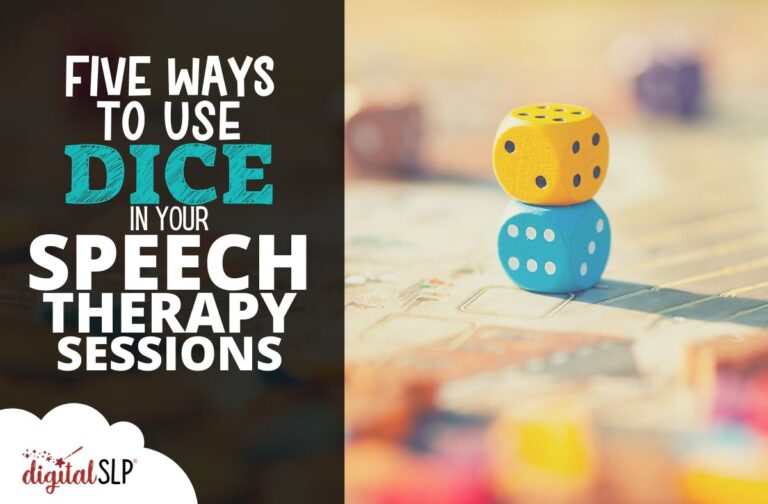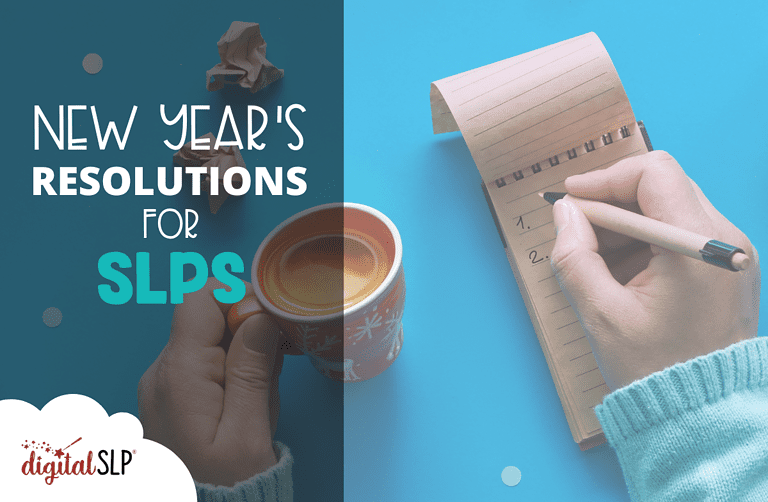Happy 2025! This year, I’m excited to bring you a monthly series highlighting ideas for how to use common therapy tools in a variety of ways. Some of the tools will be digital and some will be hands-on, but my hope is that each one will make therapy planning a bit easier—especially for mixed groups!
I’m kicking things off with one of my all-time favorite therapy items: dice! There’s something magical about these humble cubes and their ability to transform the simplest activity into something that students will request week after week. Here are five of my favorite ways to use dice in speech therapy sessions:
Articulation
Increasingly, evidence shows that frequent short sessions support articulation progress. But even in brief sessions, maintaining engagement isn’t easy, especially when you’re seeking 50–100 productions. Dice to the rescue! Give your student a target word, have them roll the dice and say the word that many times, then rinse and repeat!
The key is for the student to roll again immediately after finishing their productions, to keep the momentum going. You could also institute a “double rule” (e.g., if they roll a four, they say the word eight times) to ensure the highest possible number of productions.
If your students are working at the sentence level, you could have them roll the dice and then create a sentence that includes the corresponding number of target words. For example, if they roll a three, they’d choose three words from a list (or flashcards) and make up a sentence that includes all three. The bonus here is that you can also sneak in some language practice!
Who Goes First?
It’s a joy to have students who are excited to come to speech and can’t wait to dive into the day’s activities! That is, until it’s time to decide who gets to go first (or who helps you pass out materials, or who chooses the game, etc.). Dice are helpful here too! Just assign each student a number as they walk into the room, and then any time there’s a question about who is doing what and when, a quick roll of the dice can make the decision for you.
And of course, the beauty of this strategy is that you can assign numbers to almost anything. If the “What game should we play?” debate gets heated, pair each option with a number, roll, and go!
Narrative
Once your students know the basics of story elements and they’re ready to create their own narratives, you can use dice to set some story structure parameters. As you review each story element, roll (or have students roll) the dice to determine how many of that element will be included in the story that they develop. For example, if you roll a five for characters, the student’s story would have five characters.
This strategy could also lead to lively discussions about narratives, as students consider the implications of the numbers that are rolled. If there are six conflicts in the story, is that too many? Can a story be interesting if there’s only one character? How would it work to have three settings? After some experimentation, students could even share what they think is the ideal number for each element, and provide a rationale for their decisions.
Categories
If you want to get even more creative with your dice, try ditching the numbers altogether! It’s possible to purchase customizable dry erase dice online, or you could make a DIY option by covering the numbers with masking tape and then using a marker or pen to write whatever you’d like instead.
This is a fun way to work on categories! Simply write a category on each side, roll, and ask students to name items from the chosen category. You could also invite students to think of categories to include. You could even pair the category dice with traditional numbered dice—e.g., if you rolled “animals” and a four, students would name four animals.
Synonyms, Antonyms, Fluency, and More
Once you begin customizing your dice, the possibilities are endless!
You could write a different word on each side, roll, and have students give synonyms or antonyms for the word that you rolled.
You could write a different part of speech on each side, roll several times, and challenge students to build sentences that contain those parts of speech, in that order. This challenging activity could lead to thoughtful conversations about syntax and vocabulary; e.g., “How do you start a sentence with an adverb?”
Conveniently, there are six common wh-question words (who, what, when, where, why, how), one for each side of a die! You could write them in, roll, and ask students questions—or have students ask each other the questions.
You could even use dice for fluency work, by writing a different strategy on each side and then pairing them with conversation starters. If your students are familiar with their goals and able to read, they could quietly roll for each other at your signal, without having to pause the conversation.
I hope you and your students have so much fun with these ideas! I love dice because they remind me that sometimes all it takes is one small adjustment to make a simple activity more compelling. Enjoy!
Recommendations and Resources:
- Teletherapists can use Google’s online dice roller for traditional numbered dice, and customdiceroller.com for fully customizable options.
- Almost all Digital SLP resources include a digital die. Just scroll down and look for the clickable icon at the bottom of the page!
- As much as I love dice, I have to admit that traditional options can be loud and easy to lose, not to mention unsafe for preschoolers. That’s why I’m a fan of larger foam and inflatable options.
If you love simple, effective digital materials that can be used with a variety of age groups, consider signing up for a Digital SLP membership! Click here to learn more.
This post contains affiliate links for which we may receive compensation at no additional cost to you. Click here to read our full affiliate policy.













Recent Comments